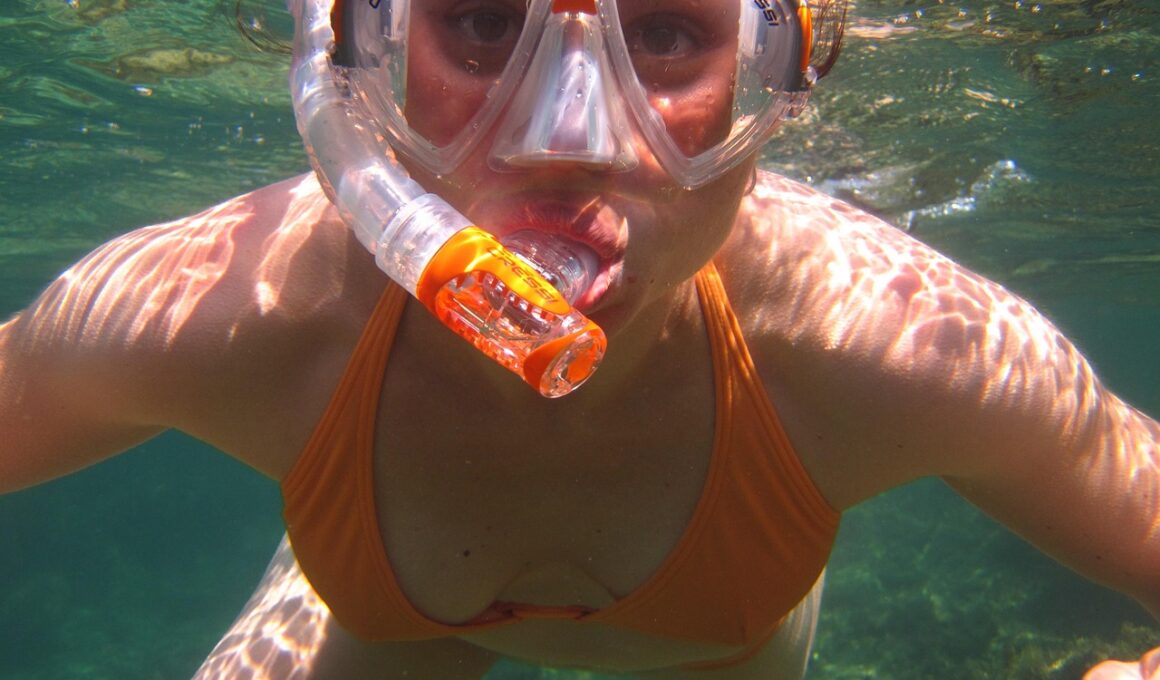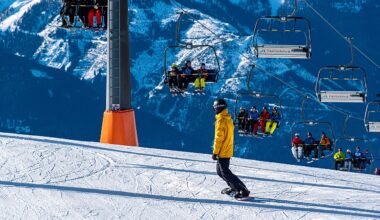Building Strength and Flexibility for Divers
Diving is a unique sport that requires a combination of strength, flexibility, and agility. To excel as a diver, having well-defined goals for physical training is vital. Strength training helps divers achieve the explosive power needed for take-off and supports their bodies as they enter and interact with the water. Moreover, flexibility enhances overall performance by allowing divers to execute intricate movements in the air while maximizing form and style during dives. Exercises focused on core strengthening provide stability, reducing accidents and enhancing the diver’s performance. Engaging in resistance training, such as weightlifting or using resistance bands, helps to build muscle strength. Flexibility can be improved through practices like yoga or Pilates, promoting better range of motion. Furthermore, a good stretching routine can prevent injuries during training sessions and competitions. Divers should also pay attention to their diets, ensuring they are consuming the right nutrients to fuel their workouts. A balanced diet contributes significantly to overall strength and flexibility, providing the energy needed to train effectively.
Hydrating before and after workouts is crucial for optimal performance. Water aids in digestion, muscle function, and can enhance the ability to recover from intense physical activity. Divers must also incorporate balance training into their routines. Balance is essential for maintaining controlled movements while in the air and when entering the water. Training on equipment like balance boards or stability balls serves to enhance core strength, improving coordination. Another effective way to improve overall strength is incorporating plyometric exercises, which build explosive power, translating directly to a diver’s performance. Examples include box jumps and jump squats. It is equally important for divers to incorporate cardiovascular training. Improved cardiovascular health contributes to overall stamina and recovery time, which are key components of successful dives. Activities such as swimming, cycling, and running elevate heart rates and contribute to overall fitness. Additionally, keeping track of progress is important for motivation. Using fitness trackers or maintaining a training journal allows divers to set measurable goals and track improvement over time, encouraging consistent practice and dedication to their training.
Essential Stretching Techniques for Divers
Stretching is an indispensable part of a diver’s training routine, as it significantly contributes to both flexibility and injury prevention. Effective stretching techniques help divers achieve the required range of motion to execute techniques required in dives. Divers should consider focusing on dynamic stretches prior to workouts, which involve movement and prepare the muscles for rigorous activity. Examples of such stretches include leg swings and arm circles that should be performed before diving practice. Post-training, static stretching becomes essential, allowing muscles to cool down and promoting flexibility. This can include stretches like hamstring stretches and shoulder stretches, which target key areas for divers. Incorporating stretches geared toward the back and hips can contribute to greater trunk rotation and increase diving capability. Moreover, certain yoga poses work well for divers; positions such as Downward Dog or the Pigeon pose are excellent for maintaining and improving flexibility. Regularly incorporating these stretches can transform a diver’s performance, making every jump, twist, and turn feel effortless. Response to training may vary, so divers should listen to their bodies and adjust their stretching routines accordingly.
In addition to these standard practices, divers should actively engage in proper warm-ups. A good warm-up routine not only primes the muscular system for the demands of diving but also reduces the risk of injuries. Incorporating foam rolling into warm-up sessions creates increased blood flow and prepares the body for aligning with performance metrics. It’s a practice that helps enhance recovery as well by alleviating muscle tightness after intense workouts. Divers could also benefit from working with a coach or trainer who specializes in diving. A professional can provide tailored training regimens that address individual strengths and weaknesses, enhancing both performance and safety. Observing proper form is an essential component of strength and flexibility training. Improper techniques may lead to injuries and decreased performance. Therefore, focusing on quality over quantity is important during training sessions, gradually progressing the intensity and resistance of the exercises to avoid overwhelming the body. Setting realistic goals with a structured approach not only fosters improvement but also enhances the enjoyment of diving, leading to a more fulfilling experience in the sport.
Nutrition’s Role in Strength and Flexibility
Nutrition plays a central role in a diver’s ability to build strength and flexibility, providing the necessary support to fuel their rigorous training sessions. A well-balanced nutritional plan tailored for divers should include macronutrients: carbohydrates, proteins, and healthy fats. Carbohydrates serve as the body’s primary source of energy, essential for maintaining stamina during intense workouts. Foods like whole grains, fruits, and vegetables provide energy and support overall health, affirming the importance of some dietary choices. Proteins are vital for muscle repair and growth, making lean meats, legumes, and dairy products great options for divers. Additionally, incorporating healthy fats from sources such as avocados, nuts, and olive oil provides further fuel necessary for both training and recovery. Vitamins and minerals, especially calcium and Vitamin D, are significant contributors to bone health and muscle function. Staying hydrated is equally vital; divers should ensure water intake before, during, and after activities to maintain optimal hydration levels. With nutrition aligned with training, divers can perform better and recover quickly, creating a balance that enhances their diving experience and overall success.
Emphasizing post-training nutrition is also crucial for diving athletes. Consuming a balanced meal or snack containing both carbohydrates and proteins soon after a workout can enhance recovery and replenish muscle glycogen stores depleted during training. Smoothies that combine fruits, yogurt, and protein powder provide a delicious and effective way to recover after intense diving sessions. Additionally, the timing of nutrient intake matters; divers should aim to eat or drink something within 30 minutes post-training to maximize benefits. Consistency in dietary habits leads to improved performance as the body learns to adapt to the demands of training. Furthermore, understanding one’s individual nutritional needs and preferences can encourage better adherence to a dietary plan, paving the way for superb diving performance in the long run. Divers should engage in educational resources, workshops, or consulting with a nutritionist to develop responsible eating strategies aligned with maintenance goals and performance enhancement. Ultimately, when strength training, flexibility routines, and nutrition align, divers find themselves naturally progressing in their sport, achieving greater heights.
Regular Evaluations: Tracking Progress
Regular evaluations are vital for divers to understand their progress in both strength and flexibility domains. Assessments should occur systematically, with divers noting the improvements in their physical capabilities. By identifying strengths, divers can work to further enhance those areas while concurrently addressing weaknesses. This strategy ensures divers are consistently moving forward. Trainers can assist by providing tailored evaluations that track various metrics, such as flexibility tests and strength benchmarks that are continuously updated during training seasons. These evaluations should not only focus on numerical gains but also consider qualitative measures, such as the improved ease of executing dives. Divers might set personal bests and achieve victories in their training, fueling their motivation to keep pushing forward. Divers can also keep a journal of subjective experiences, reflections, and sentiments experienced throughout training.Emphasizing a holistic approach to evaluations can improve overall performance as divers start to view training not just as physical activity, but rather an evolving journey full of challenges and rewards. Such methods can foster a sense of community among diving peers, aiding motivation and learning from one another.
Additionally, divers may present their progress during team reviews or training camps by showcasing their achievements and learning from others. Such environments help to inspire individuals and generate excitement about training, serving as a platform for sharing successful tips or strategies. Group training sessions allow for peer feedback, enabling divers to identify areas needing improvement while celebrating each other’s strengths. Techniques and approaches that resonate well should be encouraged, creating a culture of mutual respect and camaraderie, which is crucial for morale in competitive diving. Coaches should prioritize fostering an encouraging atmosphere that values persistence, effort, and improvement. By establishing performance goals and encouraging regular evaluations, divers gain clarity on their development while reducing the chances of burnout. The collective goal of turning challenges into triumphs not only gratifies individual divers but also enhances team spirit and contributes to the long-term success of all athletes involved. Thus, embracing a comprehensive approach to training and evaluation can ensure successful diving careers.


